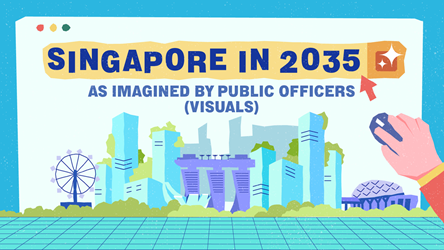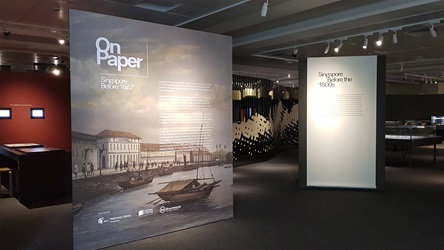Instruction Manual 2017

JARGON WATCH
Tech Jargon
Liquid content: Digital content that is memorable or references popular talking points, giving it a higher chance to go viral. Useful for reaching new audiences and promoting engagement with the brand.
Above the fold: The area of a webpage that can be seen without scrolling when the page first loads, given the device’s screen dimensions.
Mobile responsive: The ability of a webpage to automatically change its layout to display best on different sizes of mobile devices.
Public Service Jargon
MOU = Memorandum of Understanding.
A formal agreement between two or more parties that outlines the shared goals and responsibilities of each party. An MOU is often not a legally binding contract, but more of an agreement based on honour.
WOGSO = Whole-of-government strategic outcomes.
This describes goals on a national scale that require inter-ministry collaboration. For example, the national goal of building “opportunities for all” requires the combined efforts of the ministries in charge of Singapore’s education system, workforce and economy.
Say It Like This
Linux: open source operating system is pronounced “LIH-nux”, not “LIE-nux”. Though named after creator Linus Torvalds, it doesn’t share the first syllable of his name.
ASK A PRO
Personality profiling
A Q&A with JEN YING ZHEN ANG, policy officer in the Ministry of Culture, Community and Youth by day and volunteer coach by night. She is the founder of Enneagram Youth (SG), where she provides training on the Enneagram and other personality typing systems for personal development.

Many people complete personality questionnaires to learn something new about themselves: their strengths, weaknesses, motivations or behaviours they may not be aware of; and how others may be similar to or different from them. But after reading the report explaining your personality type, what do you do with the information?
Here are some tips on how to maximise the usefulness of such findings for your personal development and growth.
Q: What if I don’t agree with the findings?
A: Personality tests can differ in their validity and reliability. A test may not always profile you correctly, or yield consistent results. Regardless, if your test result does not sound like who you are, does any of the other descriptions fit you better? Reading the descriptions of other “types” can help you find a type that fits you better, or confirm your type further.
Find the type that best resonates with you. Only you know yourself in all settings – with family, friends, at work and alone. No test, and no one else, can better determine who you are.
Q: Now that I know more, how does that help me better understand my interactions with others?
A: You perceive and interact with the world through your own lenses and biases, shaped by many factors that make up your personality: your background, experiences, values, etc. They allow you to provide unique perspectives and interactions with others, but can also be an obstacle if you expect others to view and respond to situations the same way you do.
For instance, an extrovert may opt for face-to-face meetings with his colleagues, without realising that his introverted colleagues may much prefer discussing over email to have more time and space to process their thoughts.
While personality tests are not definitive, nor should they be used for stereotyping, they provide insights into our working styles and preferences, and the impact we have on others – sometimes more than we are consciously aware of. As you read about your personality type, reflect on whether there are some traits indicated that you had not been aware of before. Consider how these traits have been adaptive or maladaptive for you and your counterparts.
Q: How do I act on my findings?
A: The next time you get frustrated with your colleagues for not thinking the same way as you, make an effort to check in with them and ask what they would prefer. You will likely learn different approaches of seeing the same issue, and possibly find a fresh solution for all parties.
For example, Colleague A is a great troubleshooter who can think of many back-up plans, while Colleague B is highly goal-oriented and gets tasks done efficiently. However, they may not appreciate the other’s working style: Colleague A may see Colleague B as not being meticulous enough to anticipate the ways things can go wrong; Colleague B may see the former as a worrier getting in the way of being successful.
All personality types bring their own unique strengths and weaknesses to complement others. Sharing about these differences can do wonders for team dynamics. You will also be able to better appreciate the gifts that each person brings, and the potential roles that they can occupy.

Send your suggestions to psd_challenge@psd.gov.sg
IN NUMBERS
Social media stats
Challenge looks at how public agencies are using social media, and who’s coming up tops.
11 out of 16 ministries
…have three or more social media channels (Facebook, Twitter and YouTube). Seven have an official presence on Instagram as well.
6 videos a day
The average number of videos posted to Sport Singapore’s YouTube channel for the year 2015, with close to 2,300 videos posted altogether. Most featured content about the 28th Southeast Asian Games or 8th ASEAN Para Games.
263,000 vs. 1,612,000
The Ministry of Education has a combined total of over 263,000 likes/follows on Facebook and Twitter, making it by the most popular ministry on social media. But, wait: The Prime Minister’s Office website directs visitors to “stay connected” via PM Lee Hsien Loong’s public profiles on social media, including Facebook and Twitter. His combined likes/follows on Facebook and Twitter, at more than 1,612,000, far surpasses that of any ministry.
73.4%
The percentage of statutory boards (47 out of 64) that have a dedicated Facebook page. In this aspect, the Public Service is ahead of the national curve – the number of social media accounts registered in Singapore is at 64% of the Singapore population in 2016 (according to research by creative agency We Are Social).

GET WIRED
Make your accounts hack-proof
How to deter hackers with strong passwords that you don’t have to keep resetting.

Avoid predictable passwords
Those are the easiest to crack. Steer clear of obvious patterns such as numbers in a sequence (“1234”), or words typed forwards then backwards (e.g., “helloolleh”). The longer the password, the better. Make it a unique phrase you’ll remember – adding special characters does not always make a password more secure. Do not reuse passwords or have close variations for different accounts.
Outsource the recall
Often, a secure password is impossible to remember for the same reason it is difficult to hack: it is too long, yet meaningless. Use a password manager like LastPass to do the work for you – it generates and stores tough passwords for your various accounts. All you need is a memorable master password.
Read more: bit.ly/pwmgrcartoon
Double-confirm security
Two-factor authentication (2FA) boosts security by adding an extra layer of verification, via a code or PIN sent to your phone. Besides government services using SingPass, many Web services allow for 2FA: Apple iCloud, Dropbox, Facebook, Gmail, Microsoft Outlook, YouTube and even Twitter.
Read more: bit.ly/2FAlist & bit.ly/2Faall
- POSTED ON
Feb 23, 2017
-
Work Better
Instruction Manual January 2017








